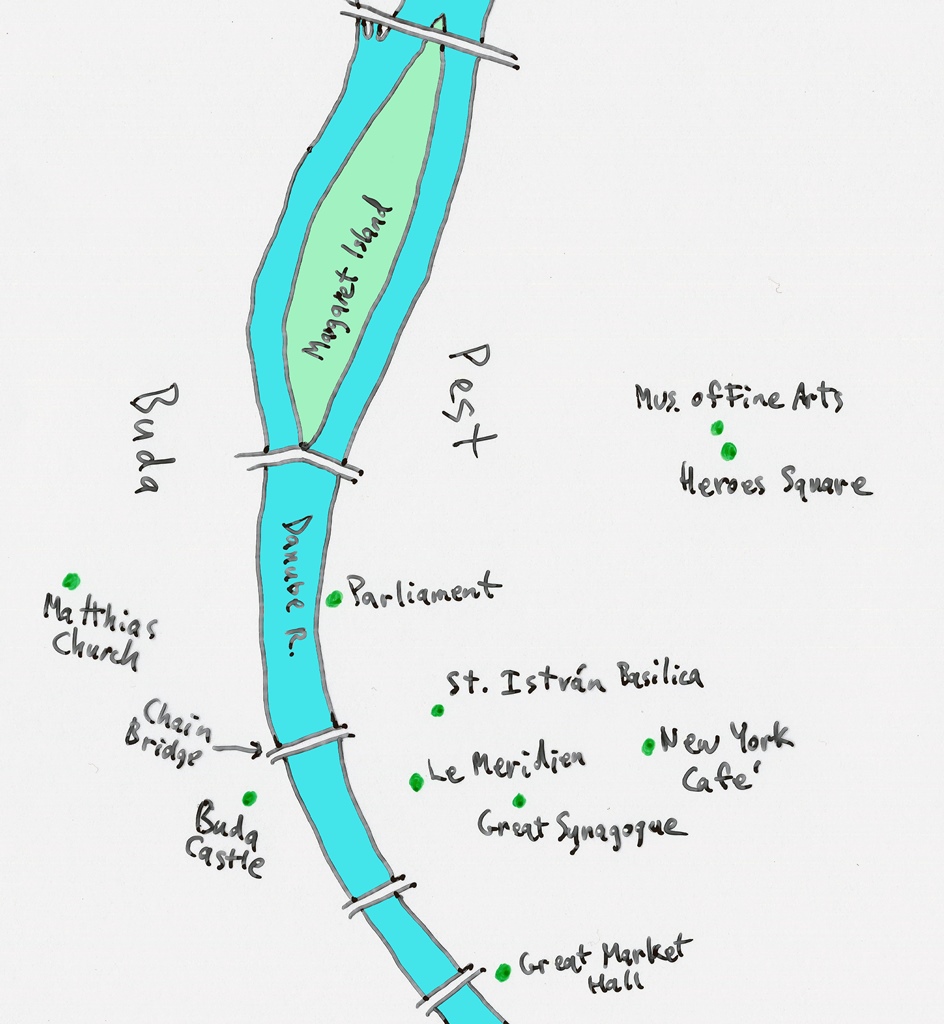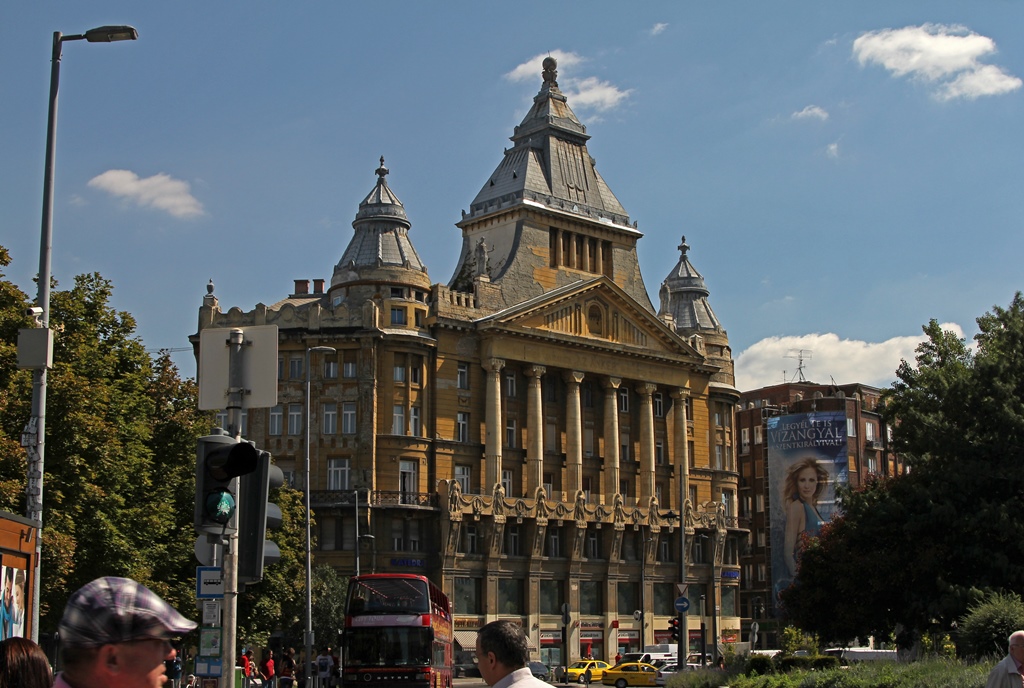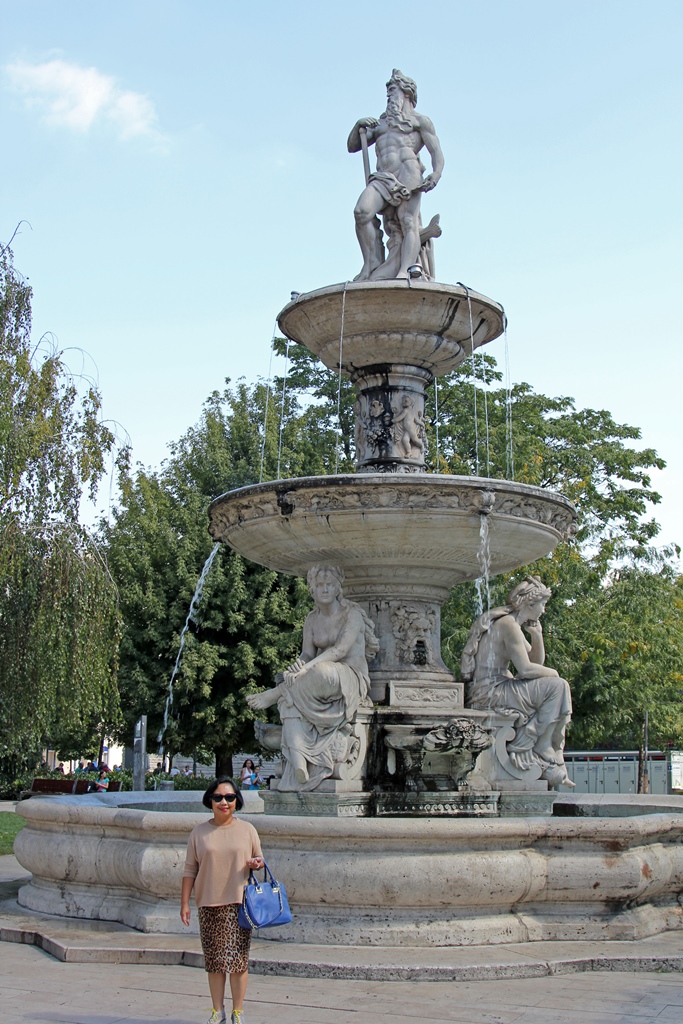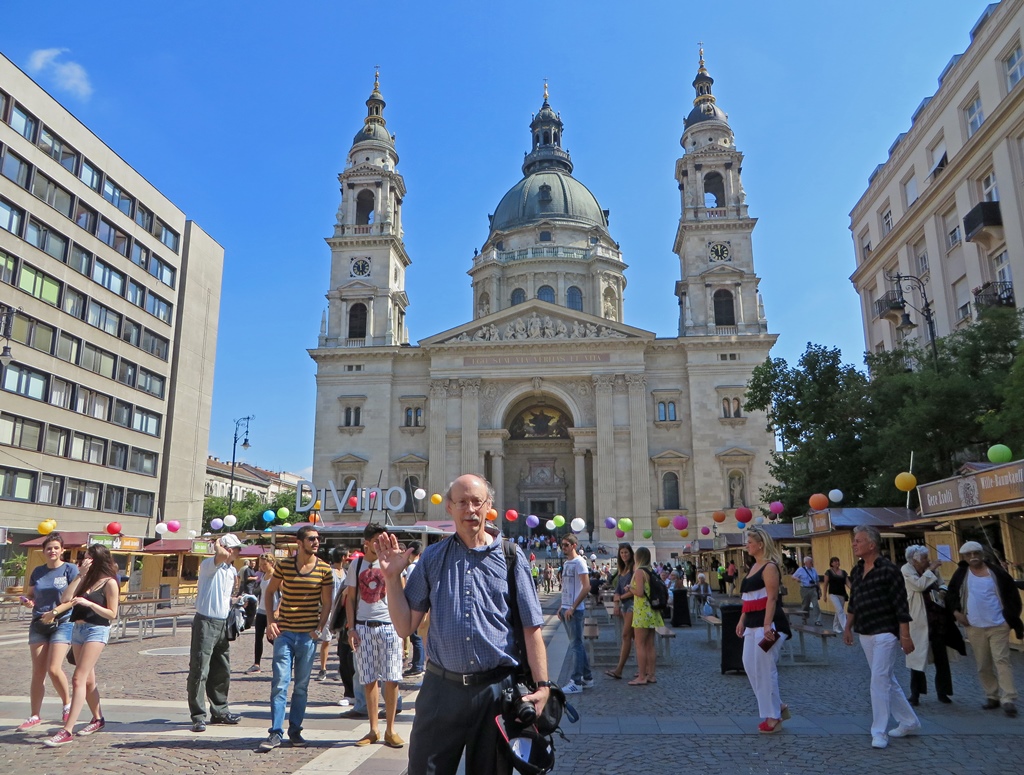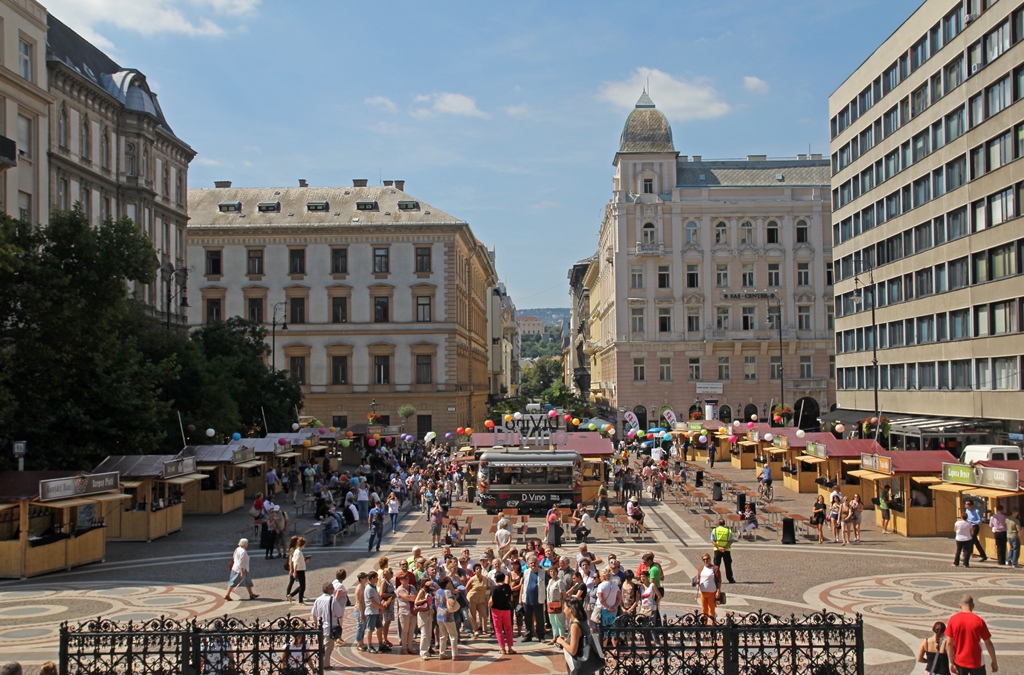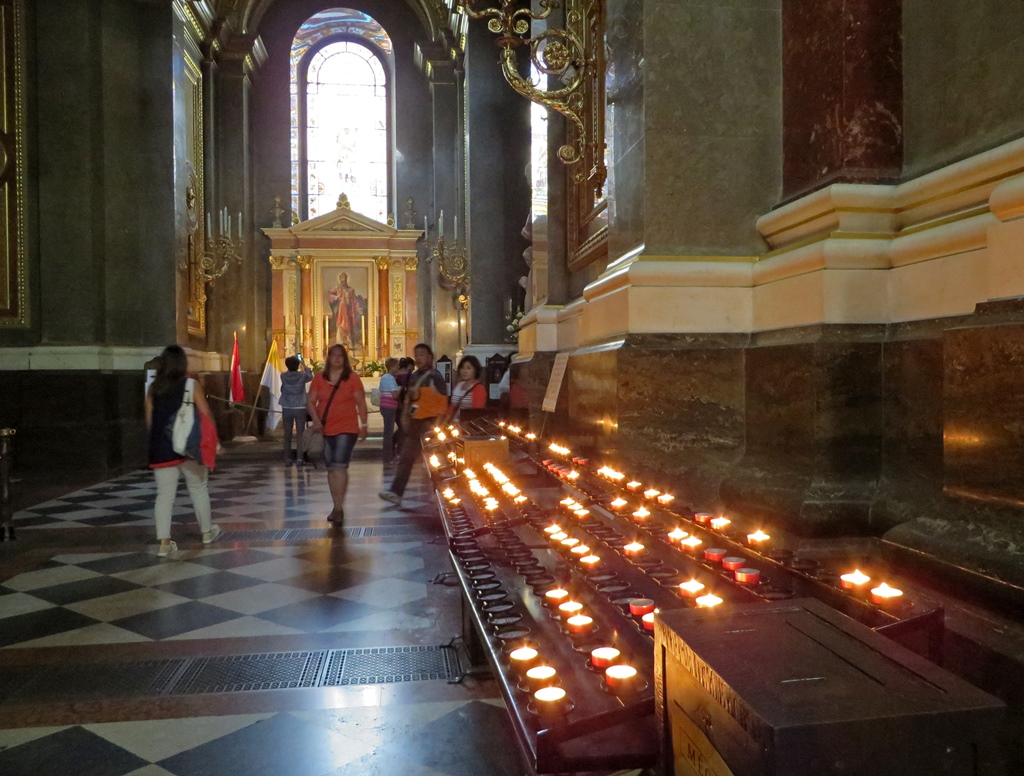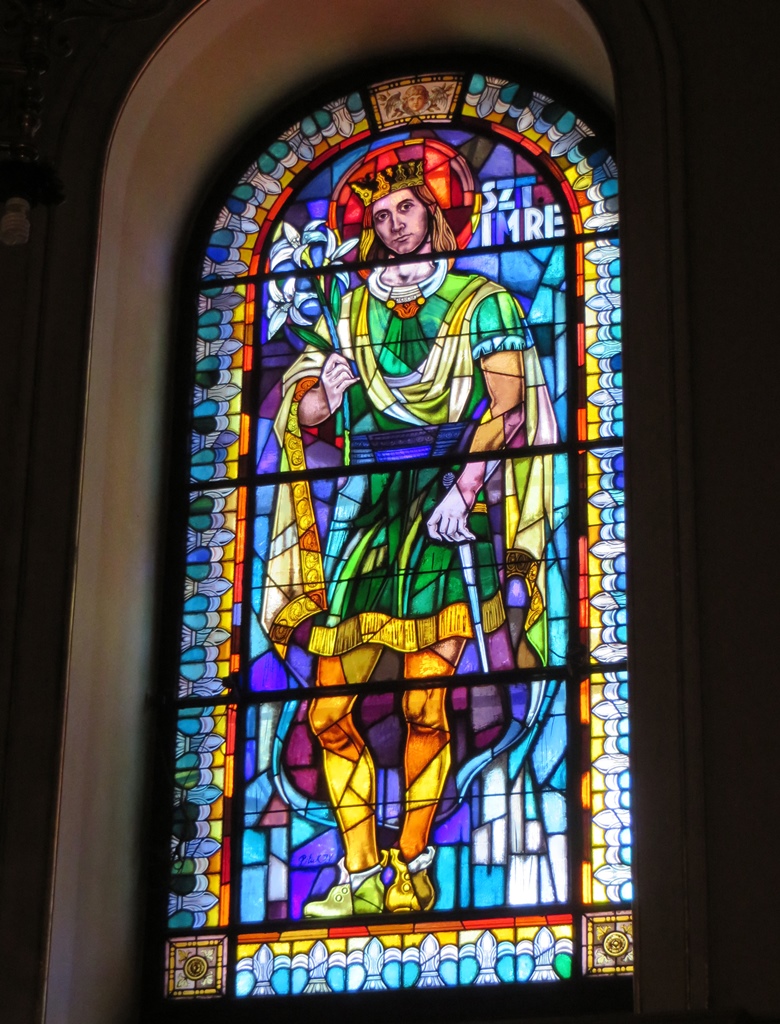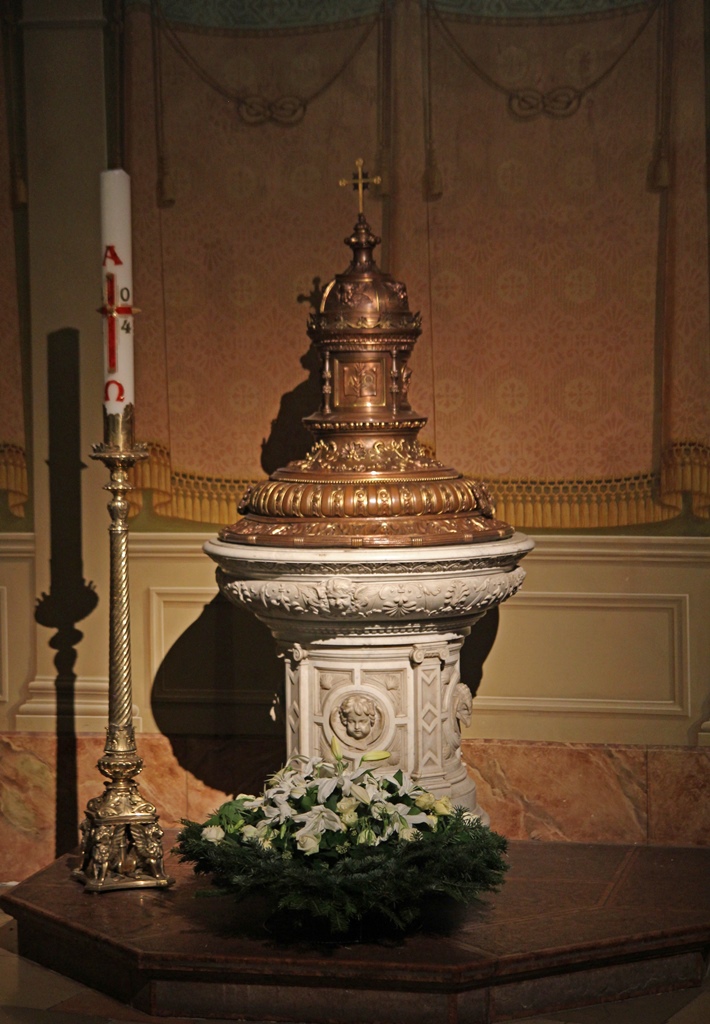Note: A YouTube companion video for this page can be found
here.
We planned on starting our first morning in Budapest by visiting the domed church we
had seen in the dark the previous evening, St. István's Basilica. But first we needed
to eat something, so we went down to the hotel's dining room to check out the breakfast
that was included with the room. The breakfast turned out to be very good, and the
dining room was gorgeous.
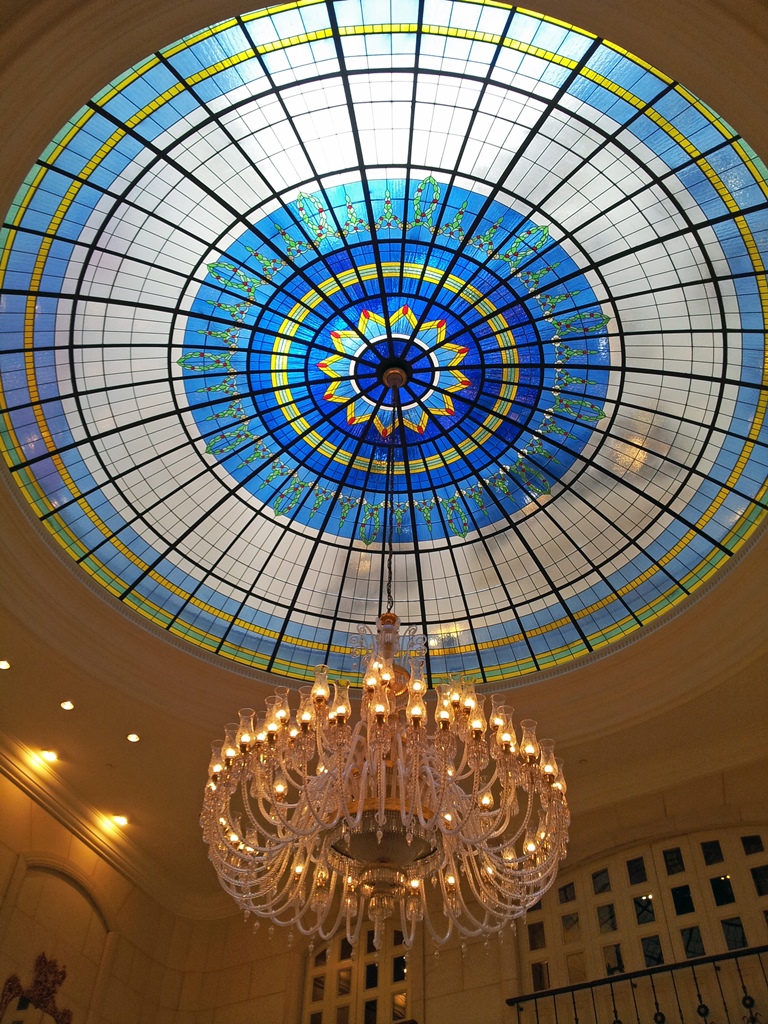
Ceiling in Breakfast Room
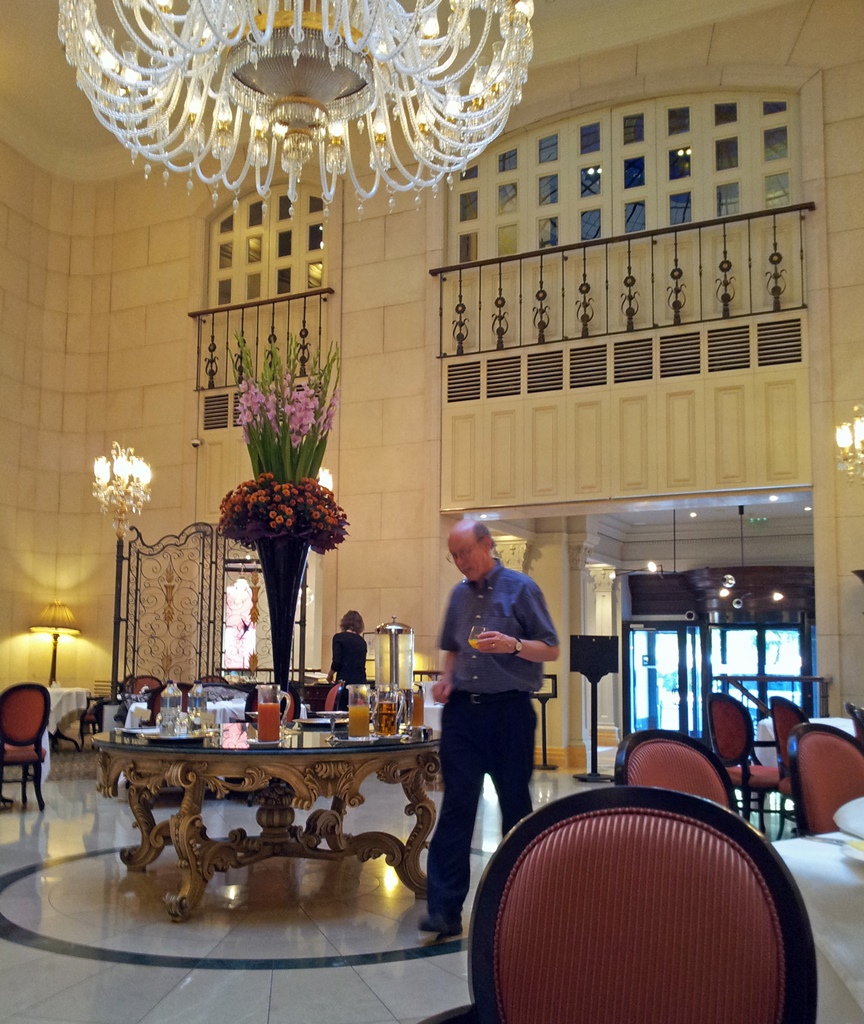
Bob and Juice Table
Well fortified, we emerged into the wilds of 21st Century Budapest.
Central Budapest
In order to cross the street in front of the hotel safely, we headed over to the
right, toward an open space called Deák Ferenc Tér. In Hungarian, a tér is
a feature that might be called a plaza or a piazza or a platz
or a place or a square in another European language. This one had a
splendid old building on it which had seen better days, but which would benefit
greatly from a bit of restoration. If the building had a name, we couldn't figure
out what it was. A number of conventional businesses appeared to be located on
the ground floor.
Building on Deák Ferenc Tér
Heading back toward our hotel, but on the opposite side of the street, we came across
a small park that turned out to be another square, this one called Erzsébet Tér, or
Elisabeth Square. This square was named for the same 19th Century Empress Elisabeth
as the Elisabeth Bridge across the Danube we'd seen the previous night, but lost its
name for a time during the Soviet years. It was first renamed for Joseph Stalin and
then for Friedrich Engels before recovering its original name in 1990. The path to
St. István's Basilica lay through this park, which had some attractions of its own.
For one, the Sziget Eye, the Ferris wheel we'd seen the night before, was located
here. Evidently there is a new Sziget Eye on Erzsébet Tér now which looks somewhat
different. We didn't ride, but I'm sure there were (and are) fine views of Budapest
to be had.
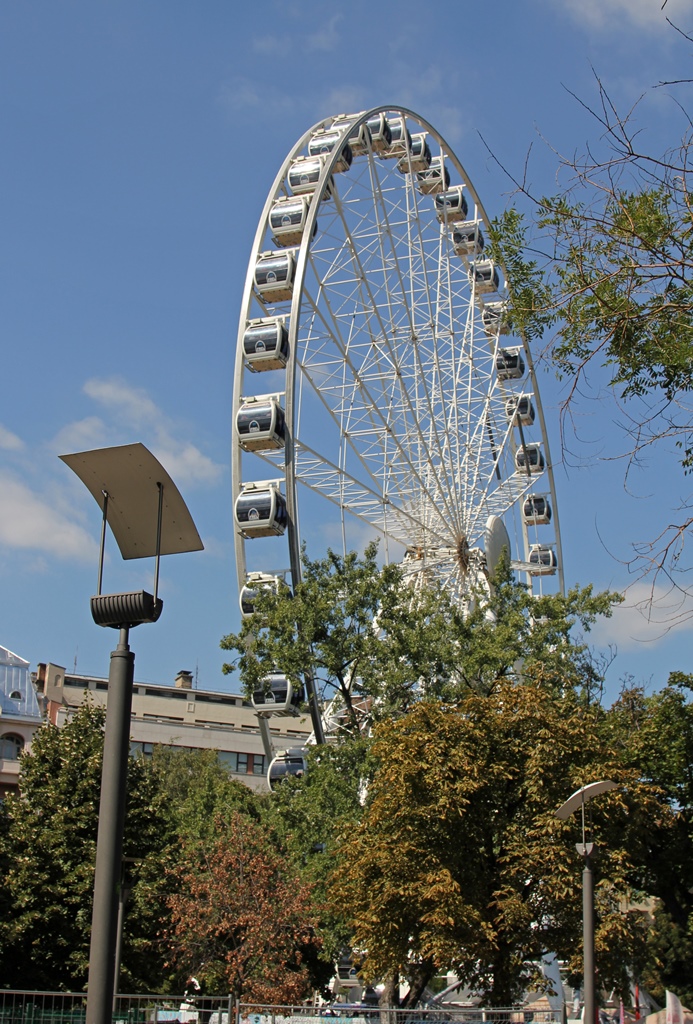
Sziget Eye Belváros
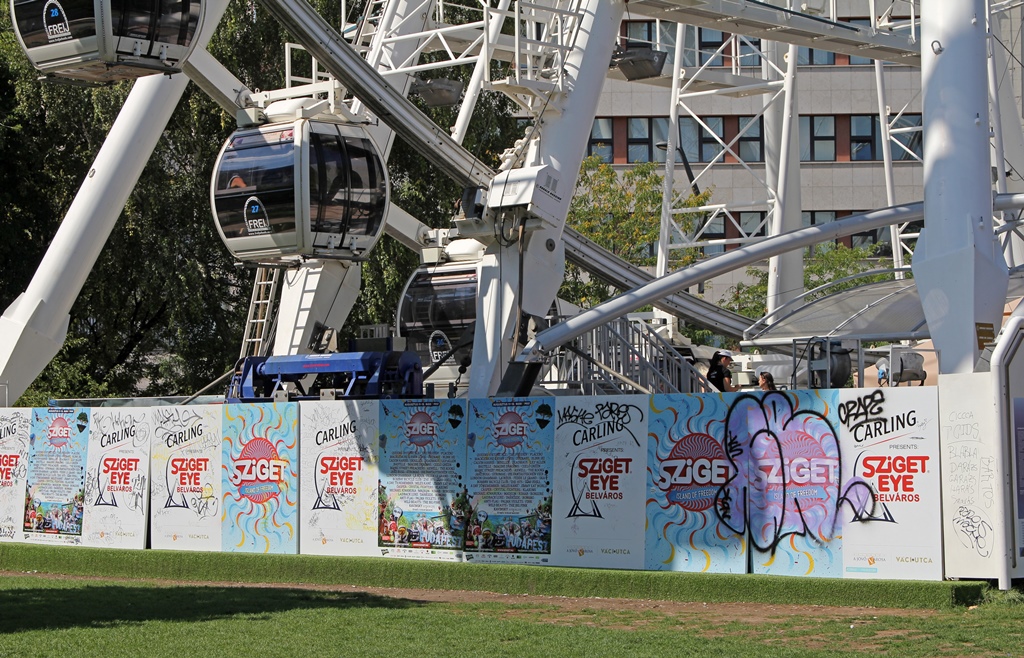
Sziget Eye Belváros
Erzsébet Tér was also the home of the Danubius Fountain, a fountain symbolizing
Hungary's rivers. The fountain was originally built in 1880 on a different square,
but was relocated here after World War II.
Nella and Danubius Fountain
A walk of a block northward took us to another square, this one in front of St.
István's Basilica. The basilica is domed and neoclassical and is named for the first
king of Hungary. If you read the introductory Budapest page, you might be a little
confused, as the first king of Hungary was introduced there with a different name.
But it makes more sense if you know that "István" is the Hungarian version of
"Stephen", making St. István and Stephen I the same person. And the square in which
we were standing is known as St. Stephen's Square, or … Szent István Tér!
Bob and St. István's Basilica
St. István's Basilica was built between 1851 and 1905, so it isn't that old when
compared to other European churches. It would have been completed earlier, but a
partial collapse of the dome in 1868 (due to sloppy construction and substandard
materials) made it necessary to knock everything down and start over. The building
is exactly the same height (315 feet) as Hungary's nearby Parliament Building,
which was completed a year earlier.
Many European churches are several centuries old, or were constructed on the site
of a previous church that was several centuries old, but this is not the case with
St. István's Basilica. The Basilica was built on the site of the former
Hetz-Theater, a venue where animal fights were staged (there wasn't any TV in those
days). Most of the Catholic tradition in Hungary in fact did not occur in Budapest
(or Pest, as it would have been at that time), but instead in a city called Esztergom,
located about 30 miles upstream. This is where Stephen I established the country's
first cathedral, which survived a number of indignities over the ensuing centuries.
When the Islamic Turks took over the country in 1543, they demolished the church, and
the Archdiocese was not restored until 1820. A mother church for the country was
built on the site of the old cathedral between 1822 and 1856. With the emergence of
Budapest as a major city, the new St. István's Basilica was consecrated as the
co-cathedral, with the Esztergom church, of the Esztergom-Budapest Archdiocese.
We made our way up the steps to the Basilica's front porch, noting some of its
architectural features on the way. There was also a nice view of the square.
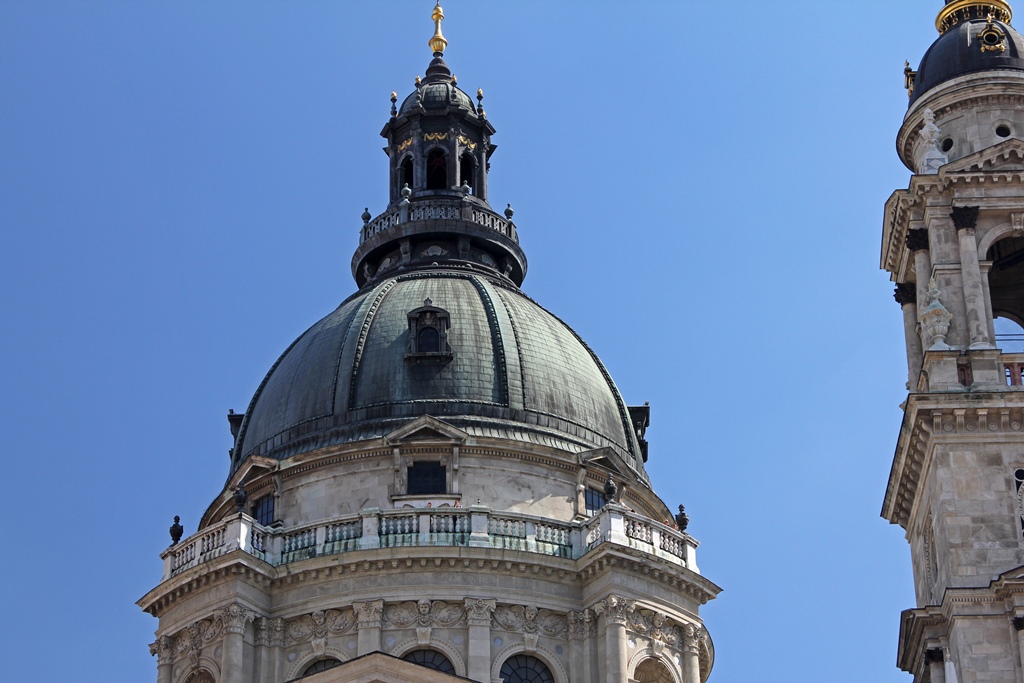
The Dome
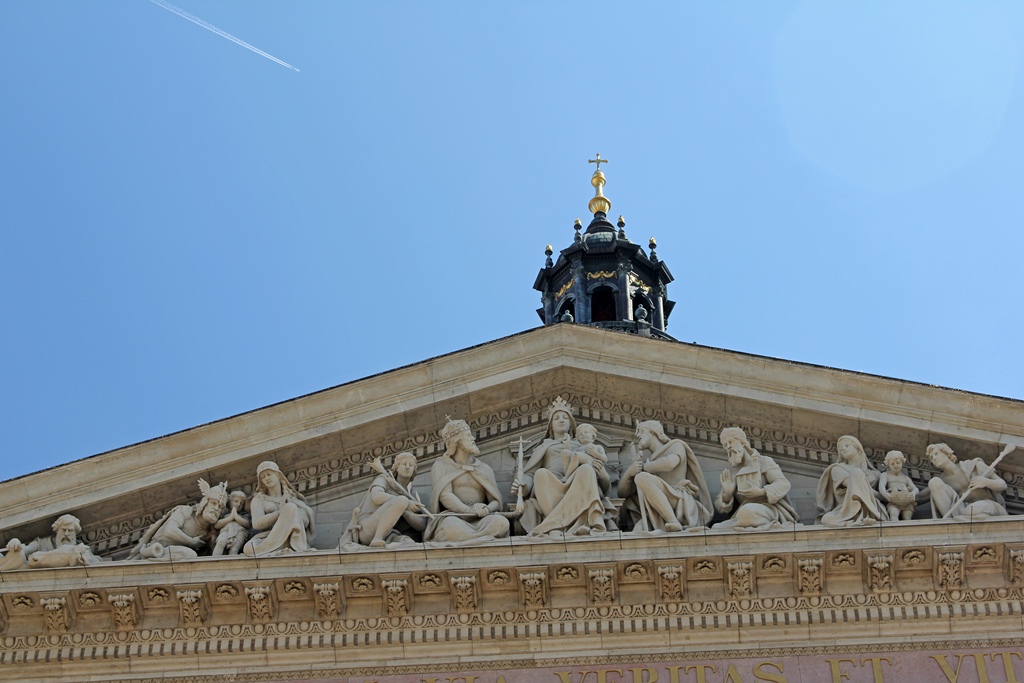
The Pediment
Szent István Tér
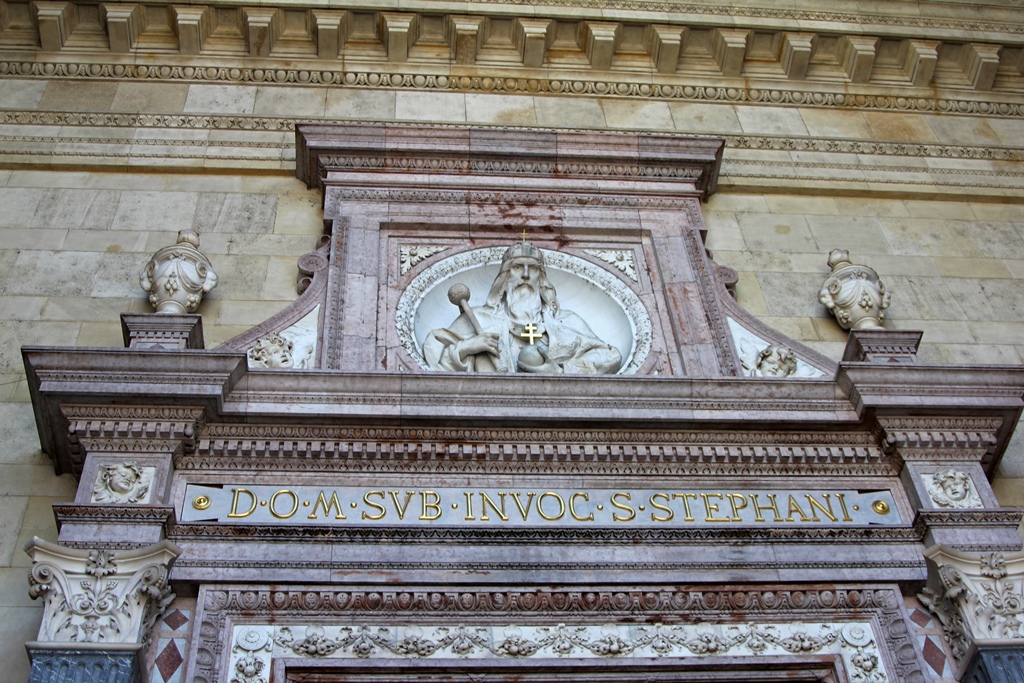
St. Stephen Above Doorway
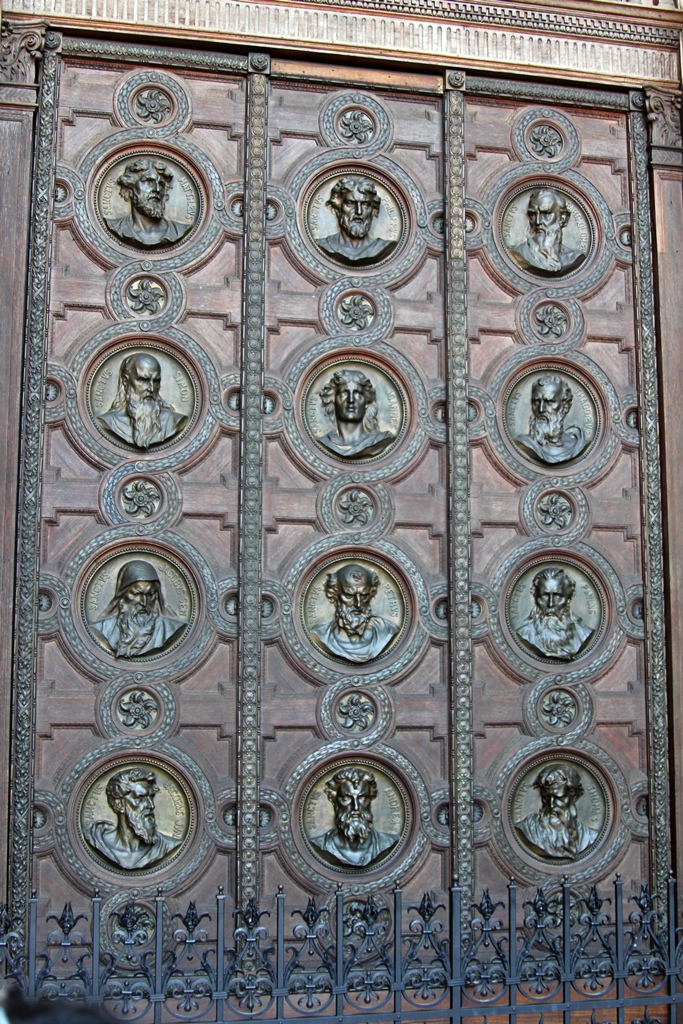
Center Door
The entrance was not through the center door, but through a door to the right.
We found the church to be beautifully decorated, with more of an open feel to
it than most churches, due to its Greek cross floor plan.
Candles and Hallway

Basilica Interior
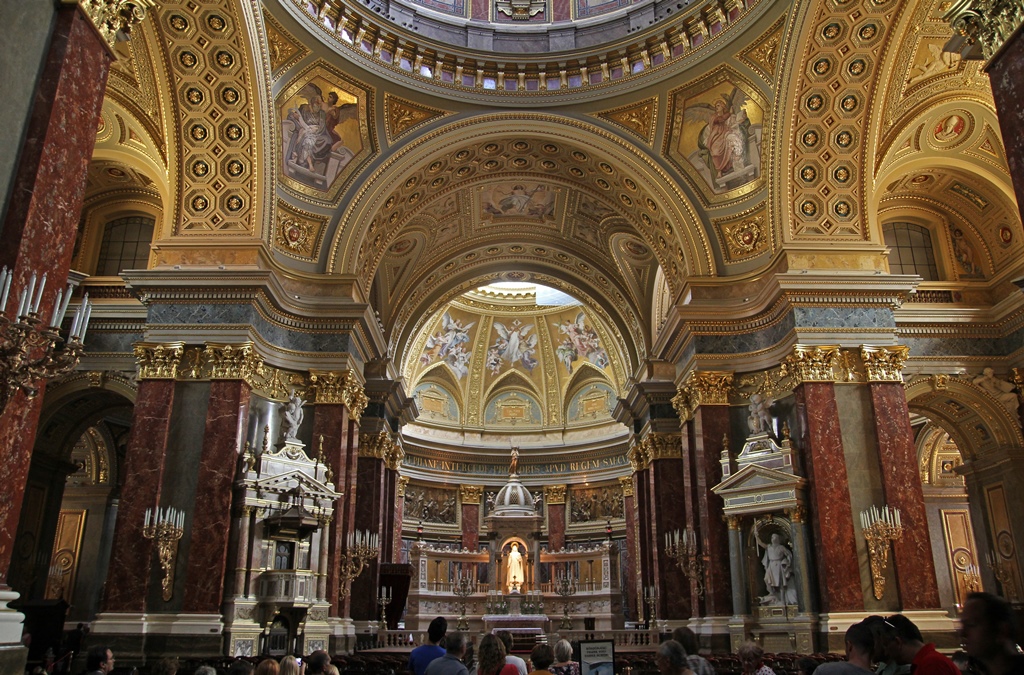
Basilica Interior

Pulpit and Dome
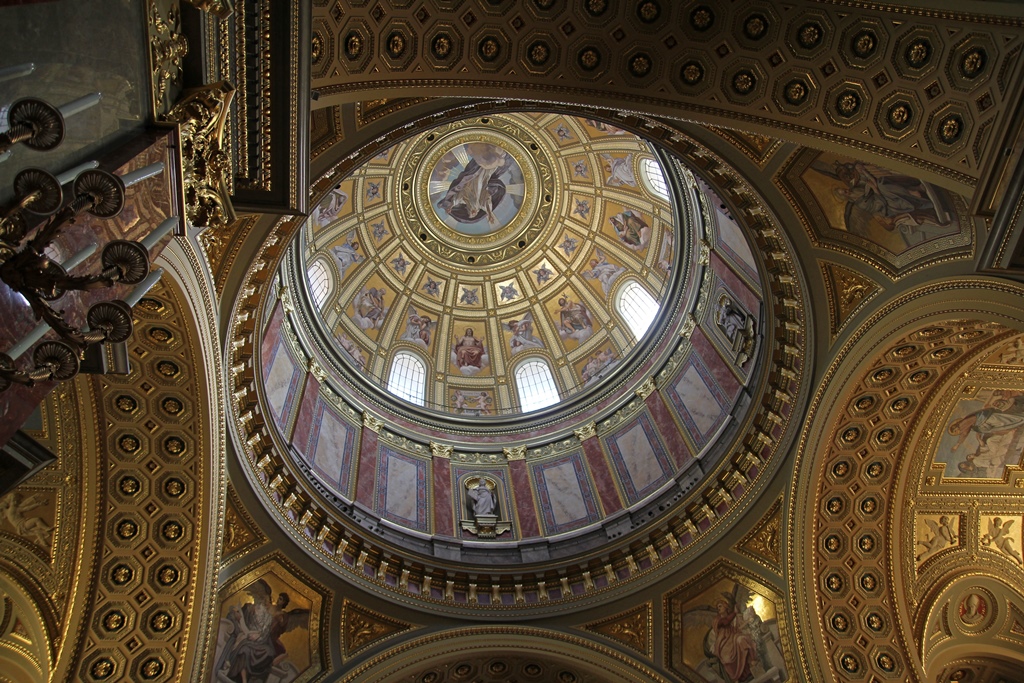
Inside the Dome
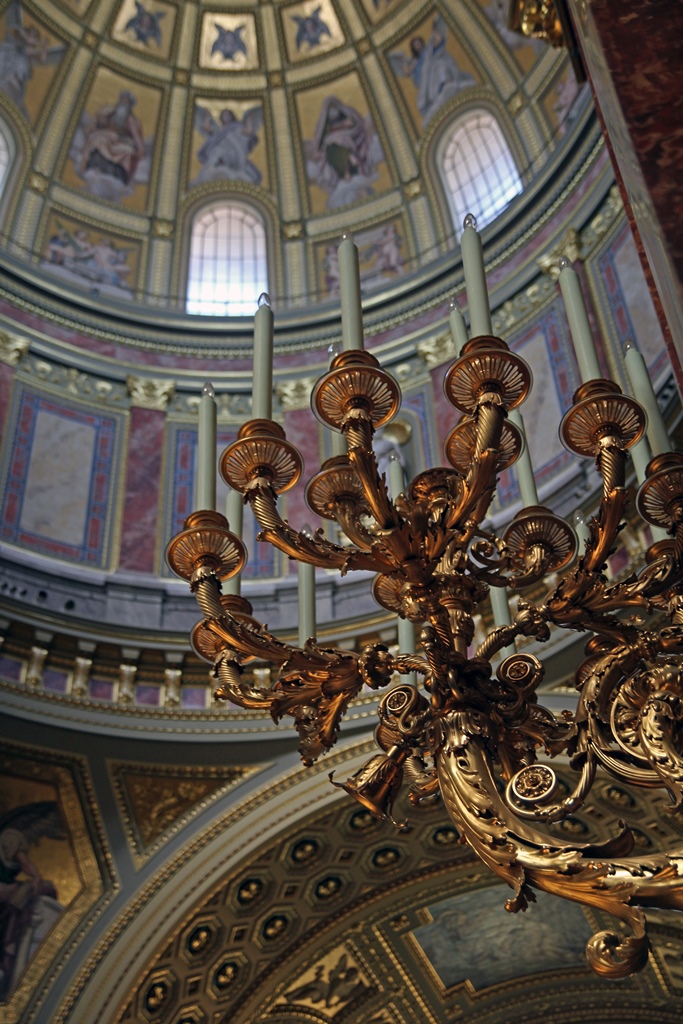
Candelabra and Dome

Seating and Dome
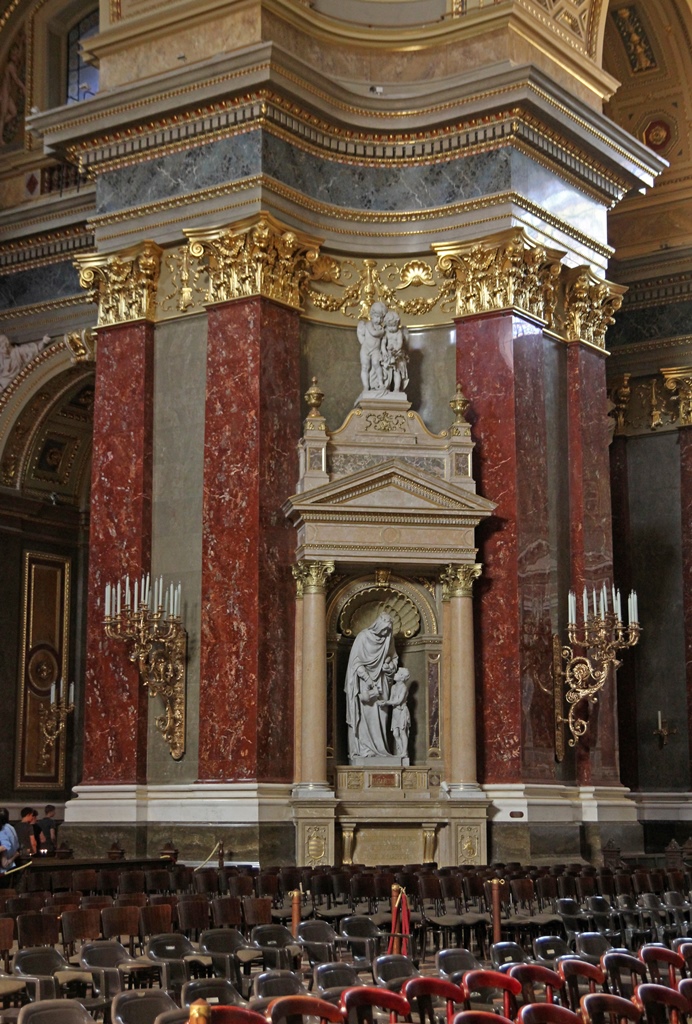
St. Elisabeth of Hungary
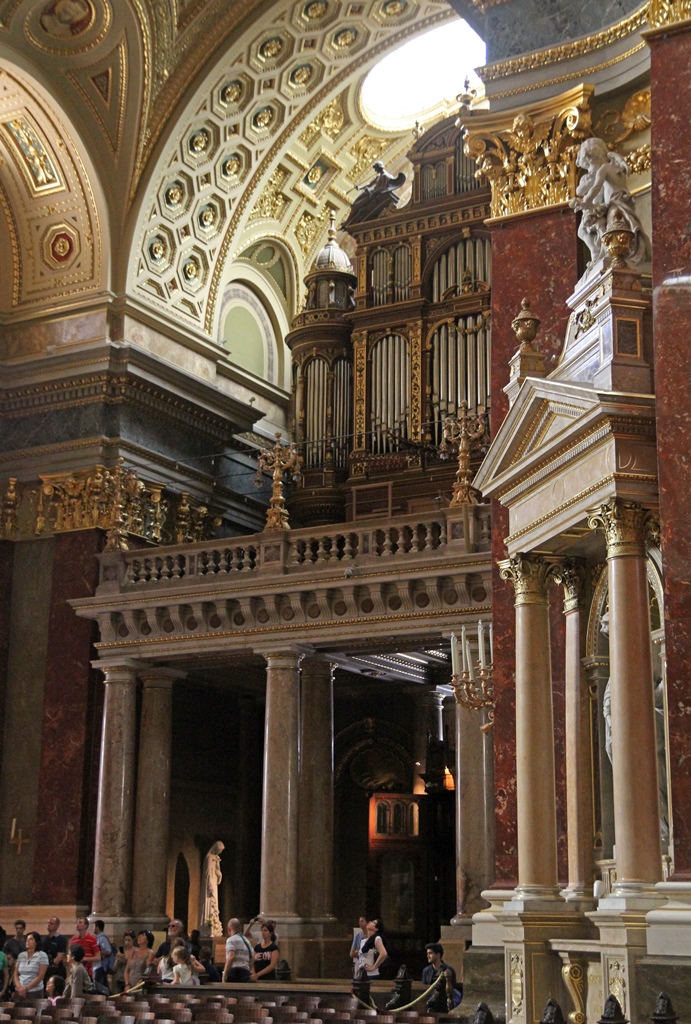
Organ
Following the Catholic plan, the Basilica had several side chapels and altars.
One of the altars celebrated St. Adalbert of Prague. According to legend, St. Adalbert
officiated at both the baptism and the wedding of St. Stephen, though there is some
doubt as to this contention.
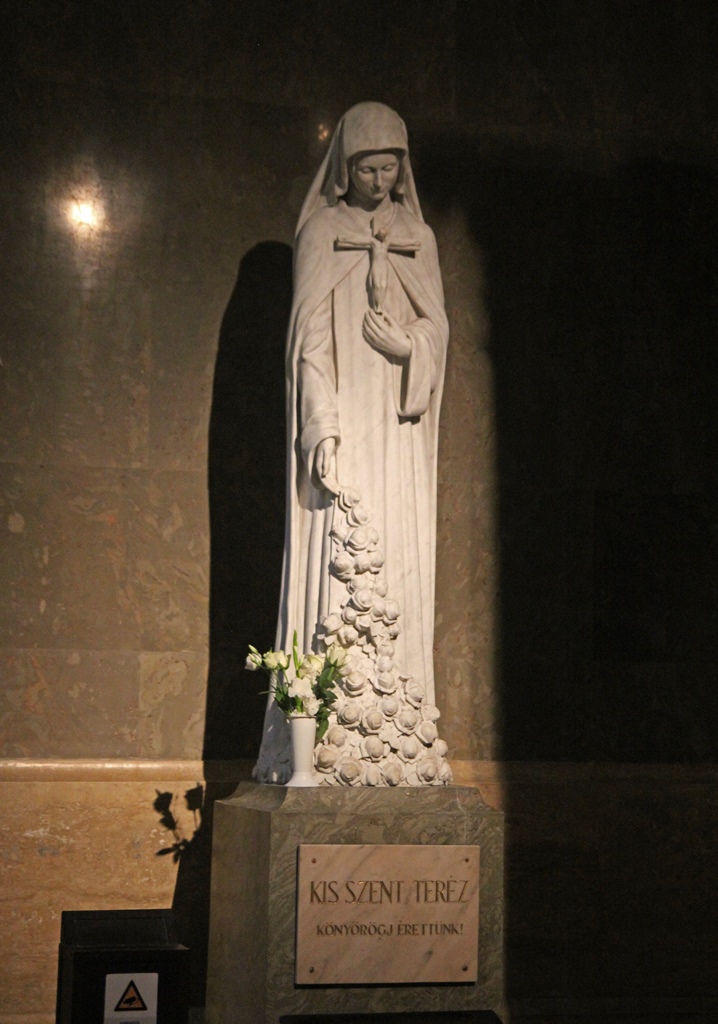
St. Teresa of Lisieux
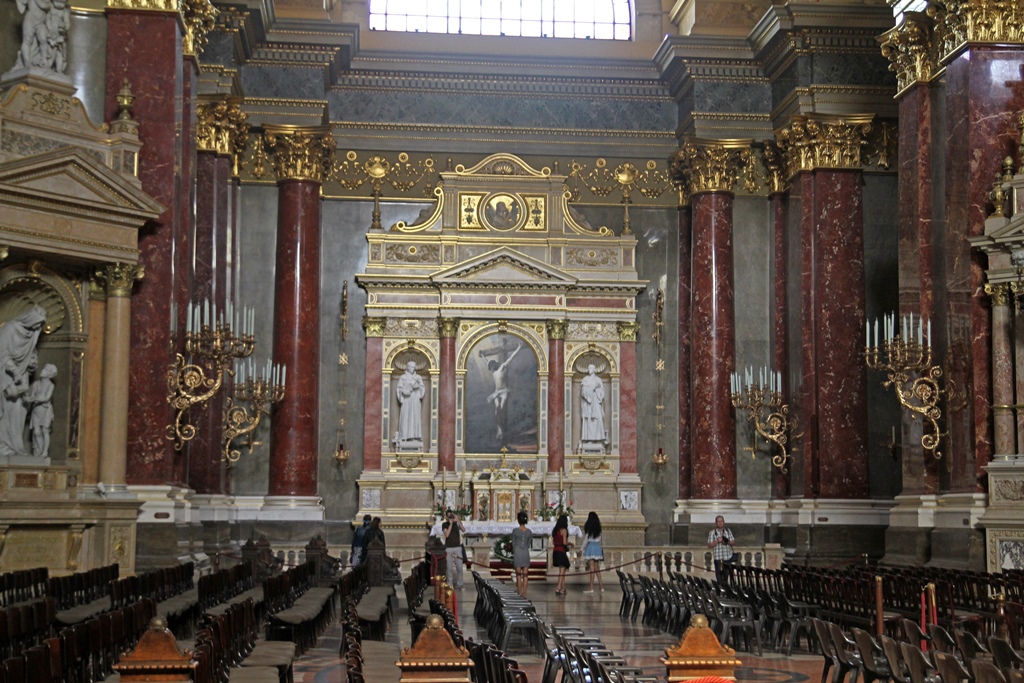
Crucifixion Altar
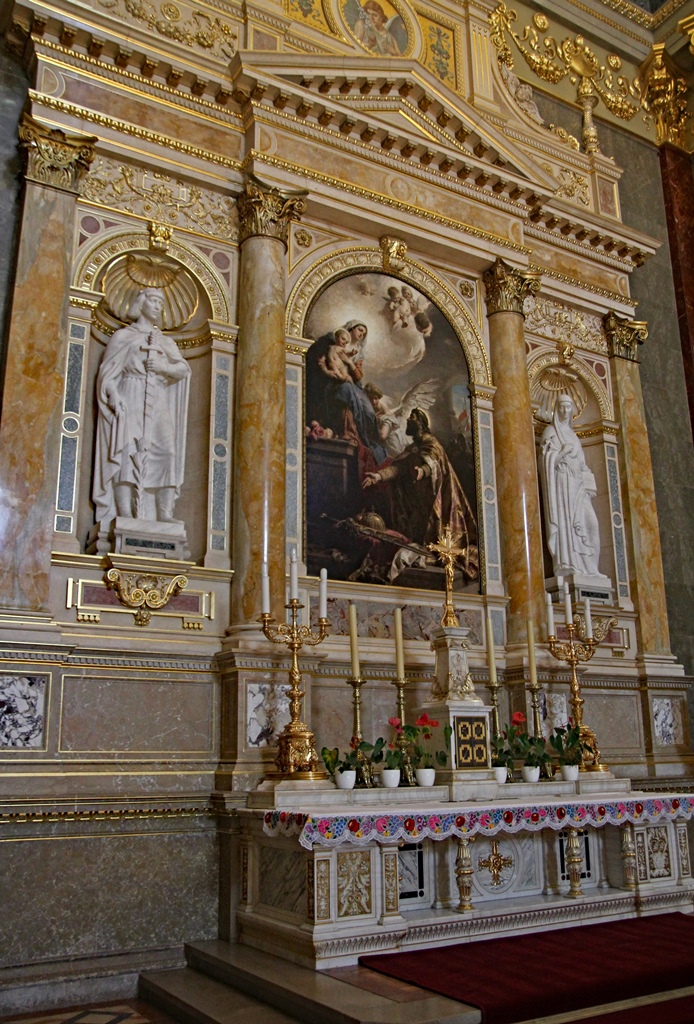
Madonna of Hungarians Chapel
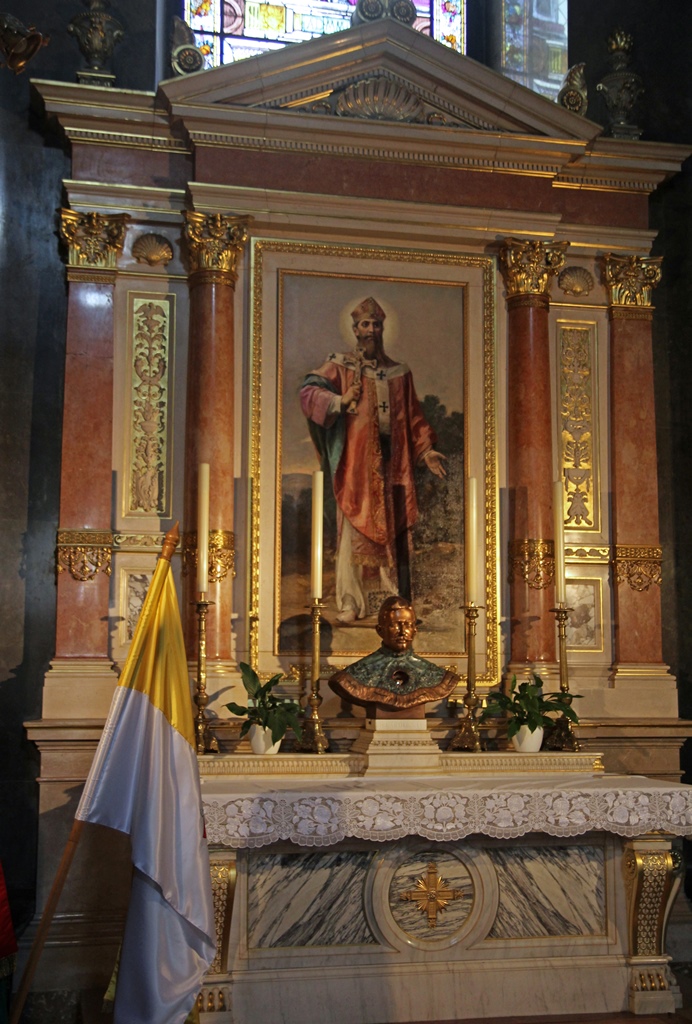
Altar of St. Adalbert
Not in doubt is the fact that Stephen's father, Géza, arranged Stephen's marriage,
in or around 995, to Gisela, a daughter of Henry II, Duke of Bavaria. They had an
unknown number of children, but it is known that only one survived to adulthood, a
boy named Emeric (Imre in Hungarian). Emeric was intended to take the
throne on his father's death, but he was rendered unable to do so in 1031, when he
was killed by a boar in a hunting accident. Things became very messy after Stephen
died in 1038, with a succession of civil wars, uprisings and foreign invasions.
Gisela left Hungary in 1045 and became an Abbess in Passau, Bavaria, where she died
around 1060. Eventually things stabilized in Hungary, long enough for Pope Gregory
VII to canonize both Stephen and Emeric in 1083 (Stephen for his devout beliefs and
his work to abolish pagan practices in Hungary, and Emeric for similar piety and
reported miraculous recoveries at his gravesite). An 18th Century attempt to have
Gisela canonized was unsuccessful, but in 1975 she was beatified by Pope Paul VI,
and is now known as "Blessed Gisela". Stephen, Gisela and Emeric all have stained
glass windows devoted to them in the Basilica.
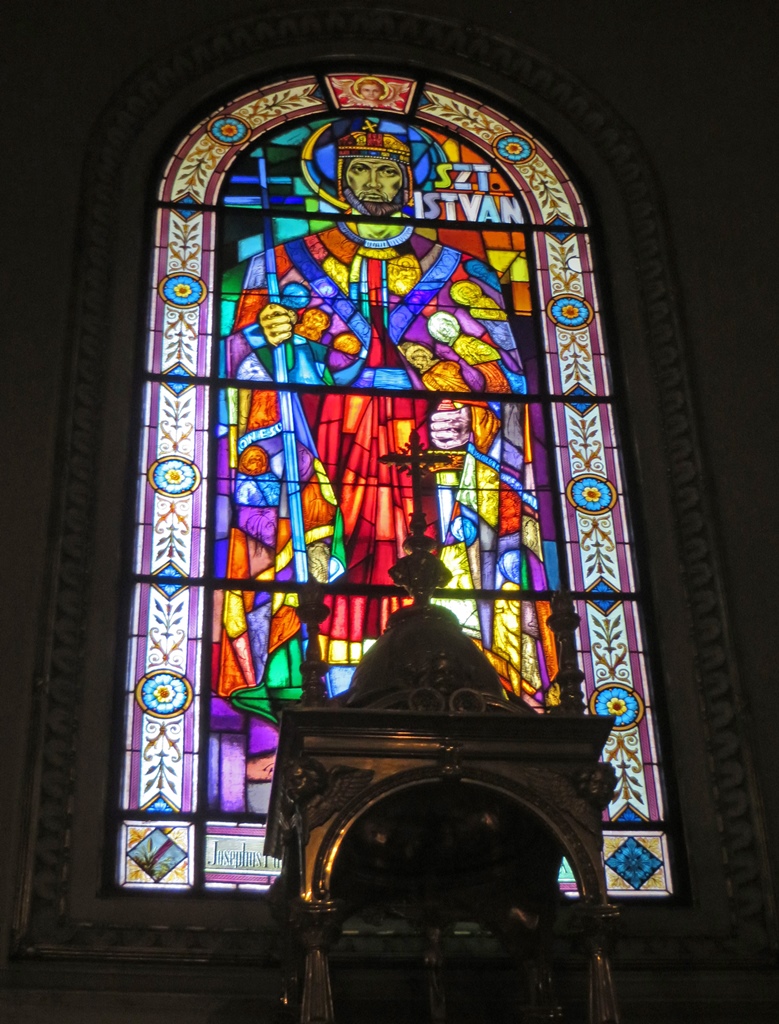
St. István Window
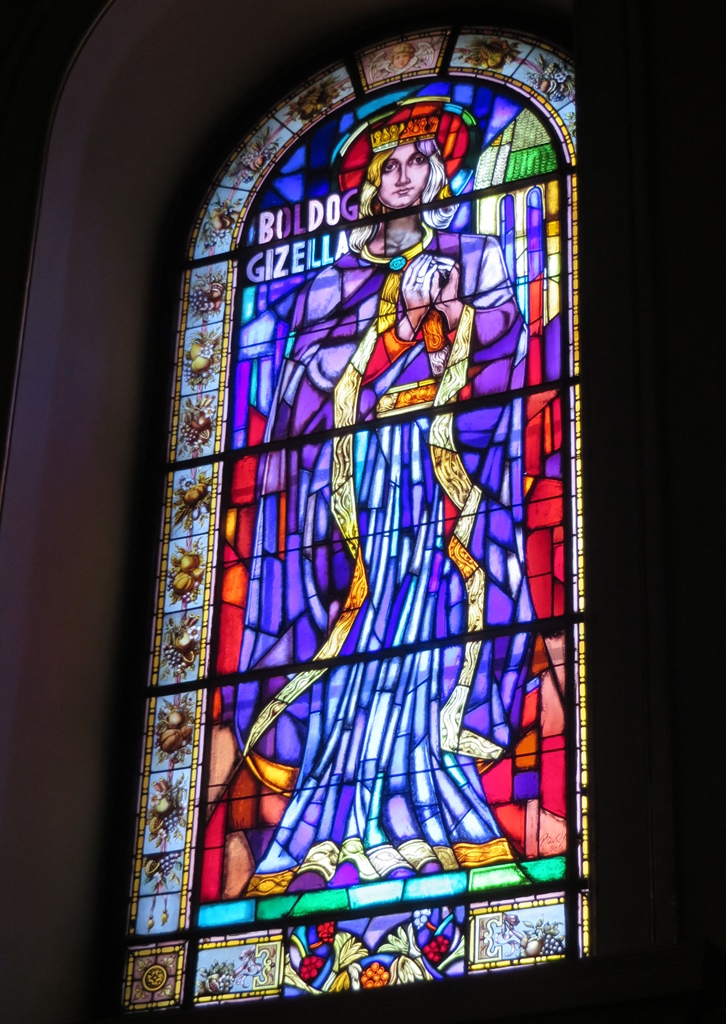
"Blessed Gisela" Window
St. Emeric Window
One cannot discuss St. István's Basilica without addressing the subject of
Stephen's right hand. It seems that it was stolen by a cleric after his death,
but was discovered, in miraculously unputrefied condition, in 1084. As Stephen
was now a saint, the recovered hand was now a holy relic and a subject of
veneration. Over the centuries the hand has travelled extensively, sometimes
to be venerated in new places and other times to be protected from invading
armies. In recent years it has gone from Empress Maria Theresa in 1771 to the
Sisters of Loreto in Buda, to Buda Castle in 1900, to a cave near Salzburg,
Austria in 1944, back to the Sisters of Loreto in 1945, and finally to St.
István's Basilica in 1950, where it remains today. There is an annual
procession in Budapest that celebrates the hand. When not being marched around
the streets, it is kept on display in the Basilica. It is said to be
miraculously preserved. I'm not sure what a thousand-year-old hand normally
looks like (nor am I particularly interested in finding out), but even though
it's been dolled up with some nice jewelry, it's not really something I'd want
to display on my mantelpiece. It probably helps to be Catholic.
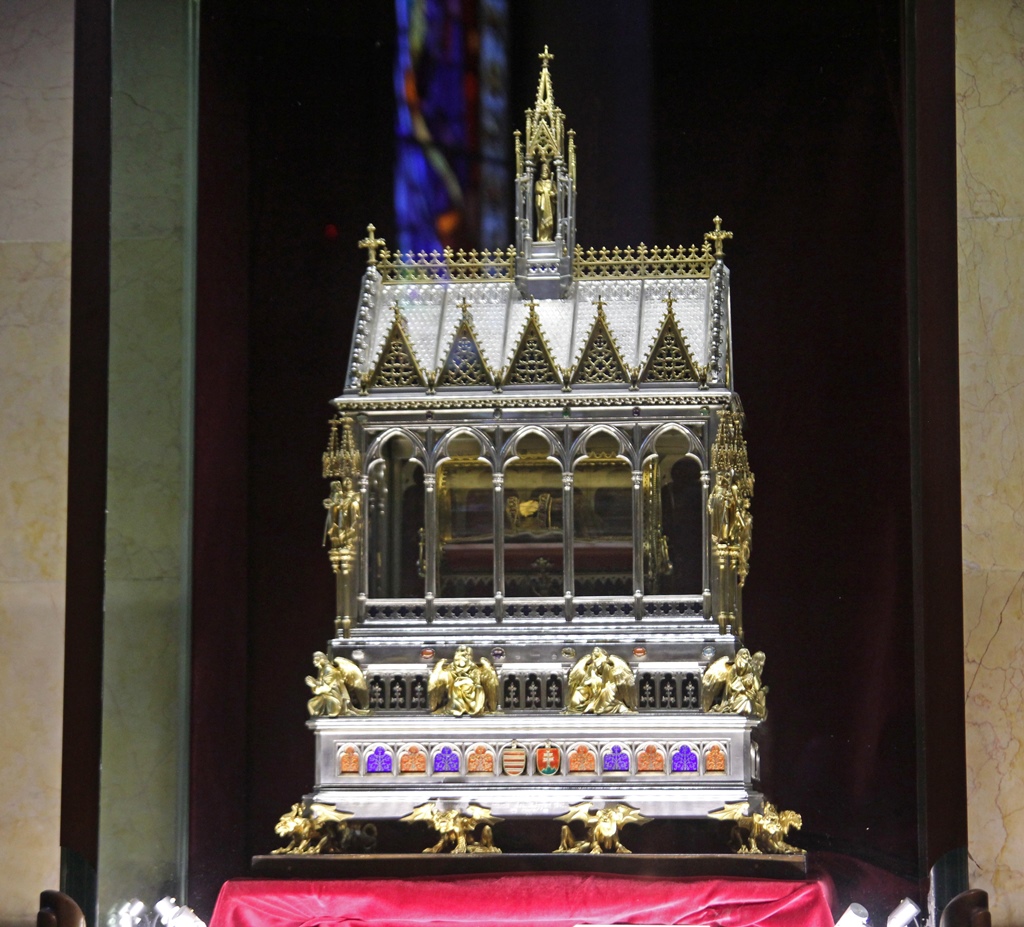
Reliquary of St. Stephen's Right Hand
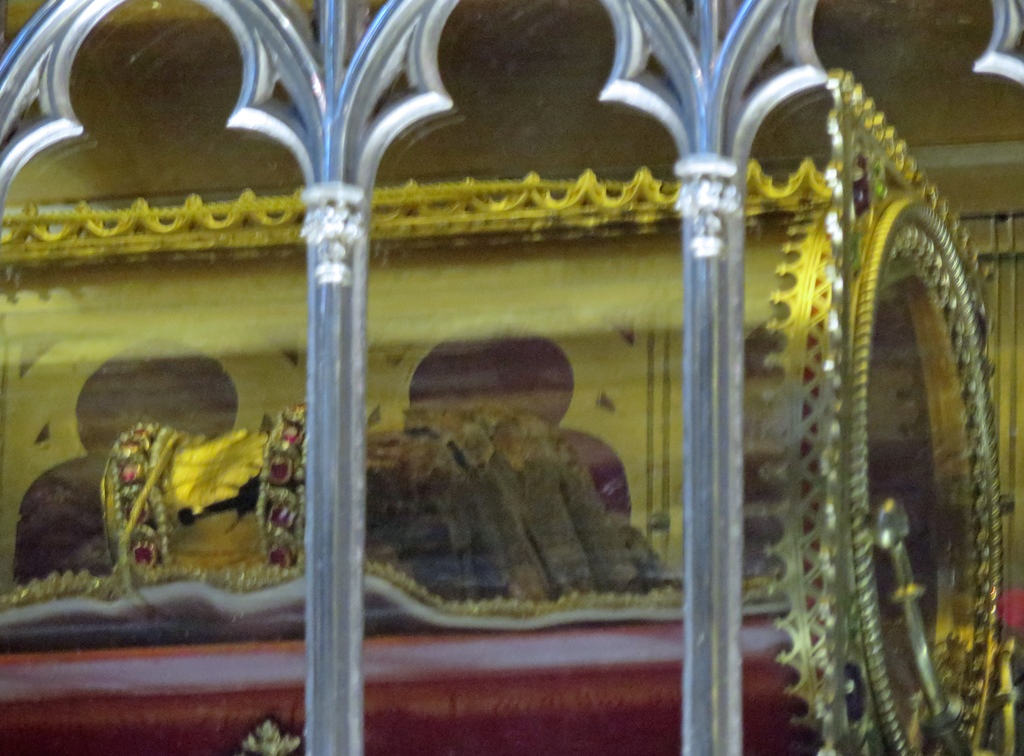
St. Stephen's Right Hand
Baptismal Font near The Hand
After having our encounter with The Hand, we did a little more exploring around
the corridors of the Basilica before eventually exiting back into the Hungarian
daylight.
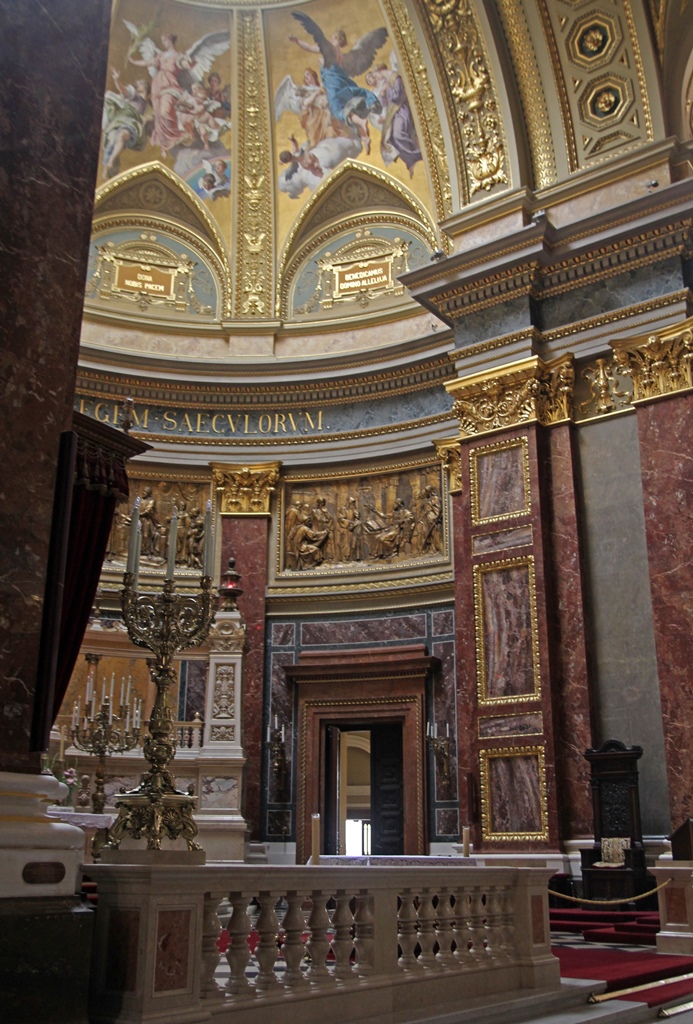
Main Chapel
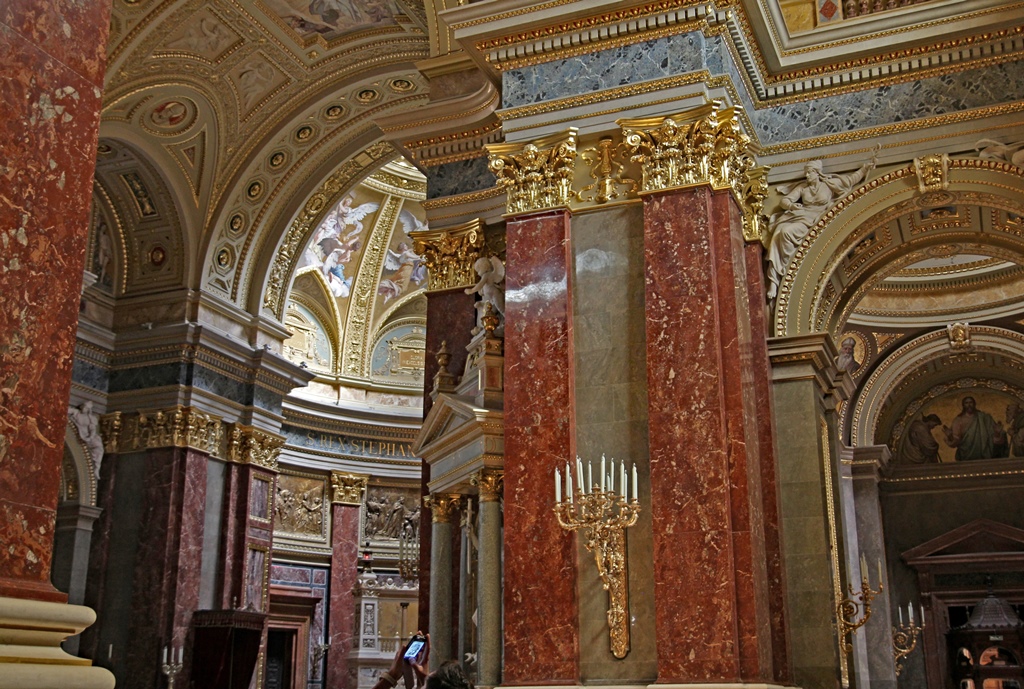
Decorated Hallway
Our next destination for the day was to be the Museum of Fine Arts, and we set
to figuring out how to get there.



